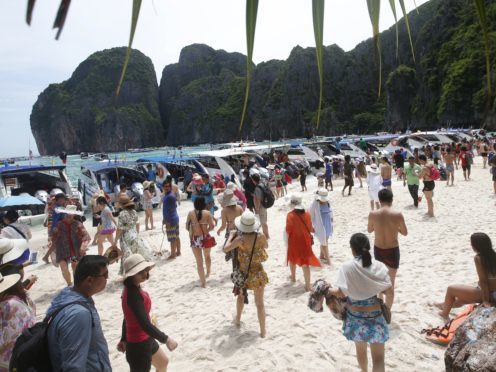The secluded Thailand bay made famous by Leonardo DiCaprio movie The Beach is being closed to visitors after being pushed close to exhaustion by mass tourism.
Maya Bay on Phi Phi Leh Island in the Andaman Sea will close to tourists for four months from Friday to give its coral reefs and sea life a chance to recover from an onslaught that began nearly two decades ago.
A daily influx of dozens of boats has seen thousands of visitors unsuccessfully scrambling for an unspoiled view of glistening white sands and emerald waters.

Thai authorities, who have promoted unfettered tourism but now claim to be striving to balance profit and conservation, say the closure will happen every year.
It is part of a rethink happening globally about unrestricted tourism that brings big money but damages historic sites, harms the environment and often alienates locals.
Last month, the Philippines began a six-month closure of popular Boracay Island, whose waters President Rodrigo Duterte described as a “cesspool”.
Venice, the famed Italian lagoon city that lives off tourism, installed gates at two access bridges during a four-day holiday in April so it could turn back visitors if numbers became overwhelming.

Many of Thailand’s marine national parks are closed from mid-May to mid-October during the monsoon season but, because of Maya Bay’s popularity, it has not had a break since director Danny Boyle’s crew set foot on its sands in 1999 to film the dark backpacker tale based on a novel by Alex Garland.
Its corals have been decimated by suffocating clouds of sand and sediment churned up by speedboats.
“I tried to push this campaign for many many years, but you know in Thailand we are a tourism industry country and we need a lot of money, so before not so many people listened,” said Thon Thamrongnawasawat, a marine biologist and member of a government committee on development and the environment.
“It should have been done 10 years ago but at least it has been done.”

Thailand had about 35 million international visitors last year, a five-fold increase in little more than two decades.
The head of Phi Phi Tourist Business Association, Watrapol Jantharo, said he was surprised when the closure was announced in March.
He said locals were under the impression that Maya Bay would only be closed to boats, while visitors would still be able to walk to the bay from the other side of the island.
“We are not against protecting our environment,” he said. “We know full well that Maya Bay is our important resource, like a rice field to a farmer, but we wish there are more communications about the government’s plan before the decision was made.”
The government has set a limit of 2,000 tourists a day when the bay reopens — about half the current cap. Boats will no longer be allowed to anchor but must dock on the opposite side of the island.
